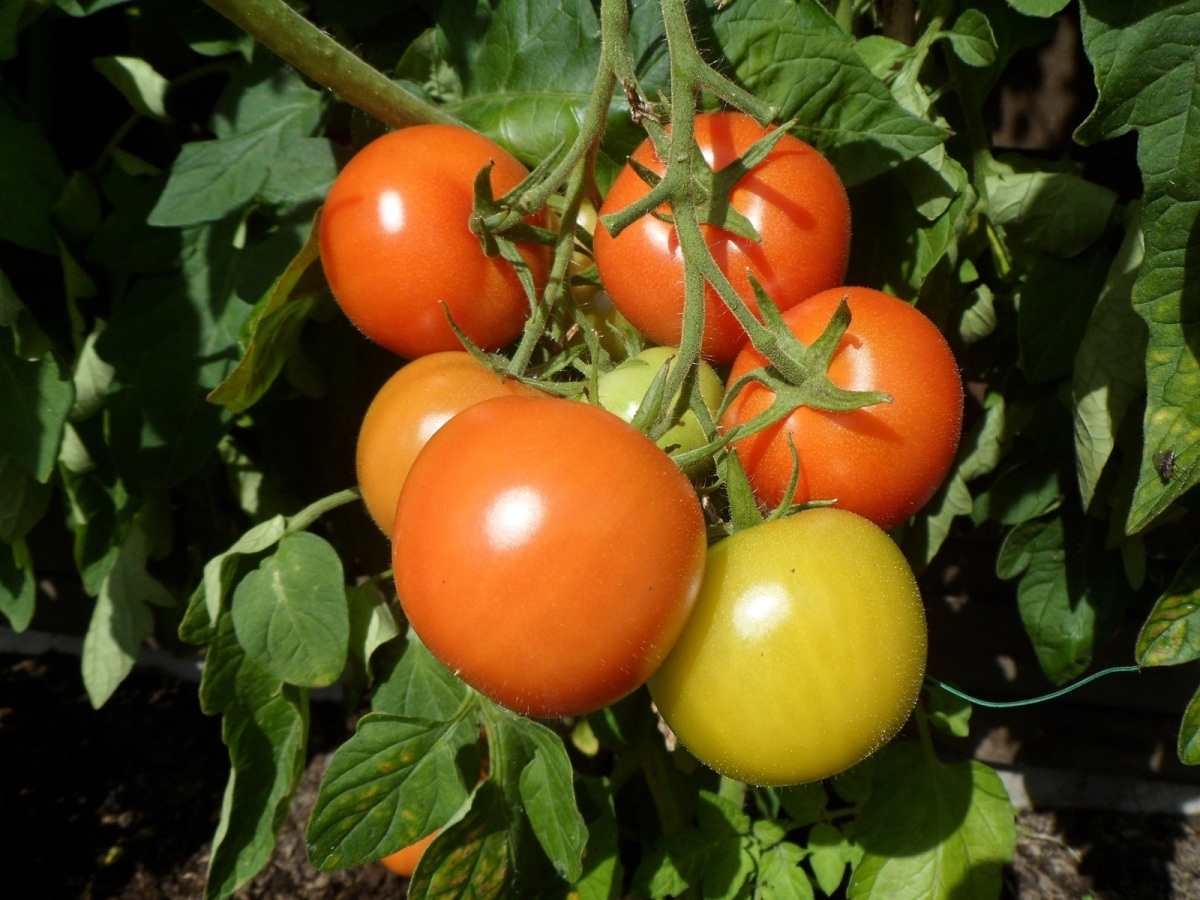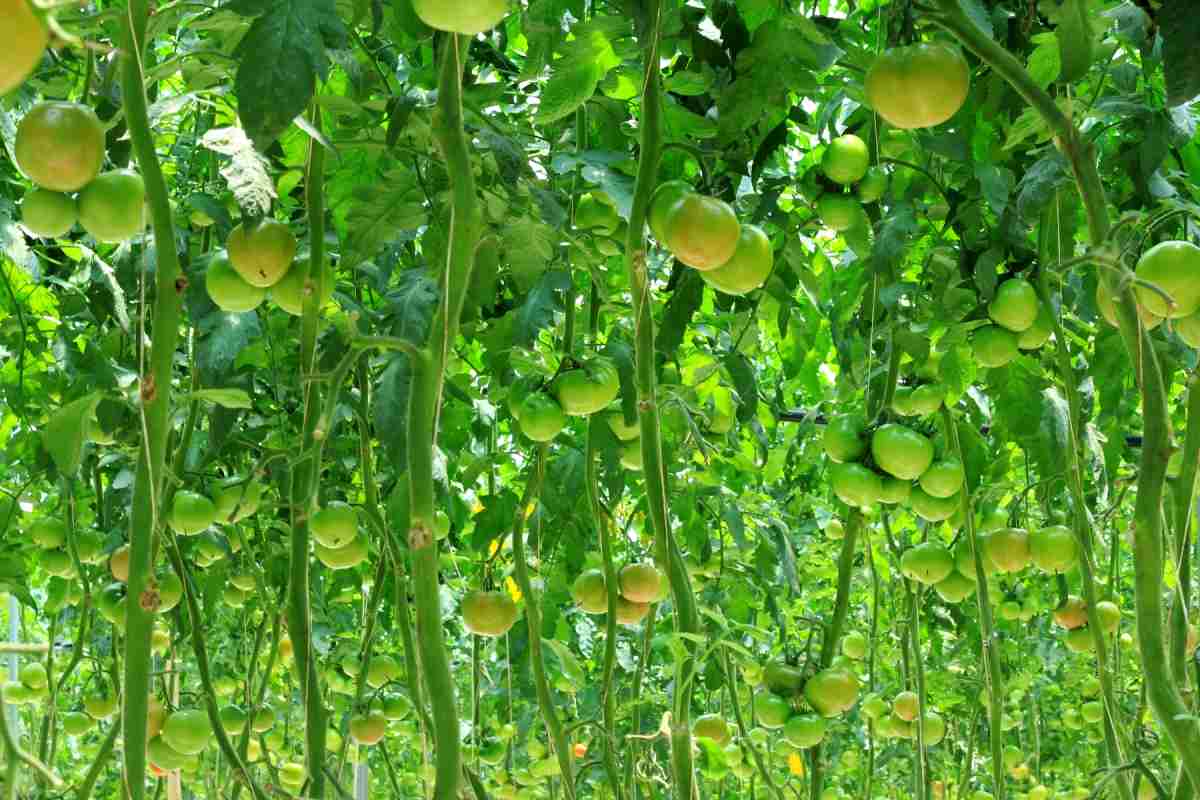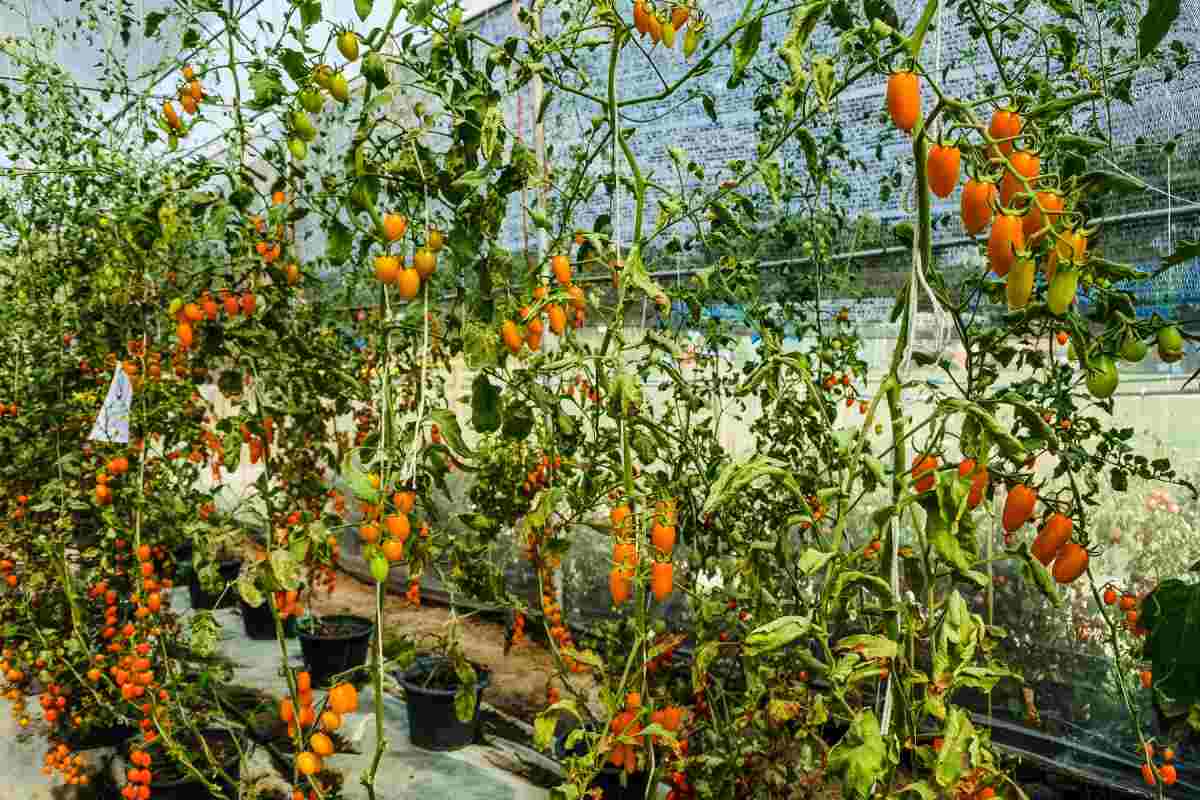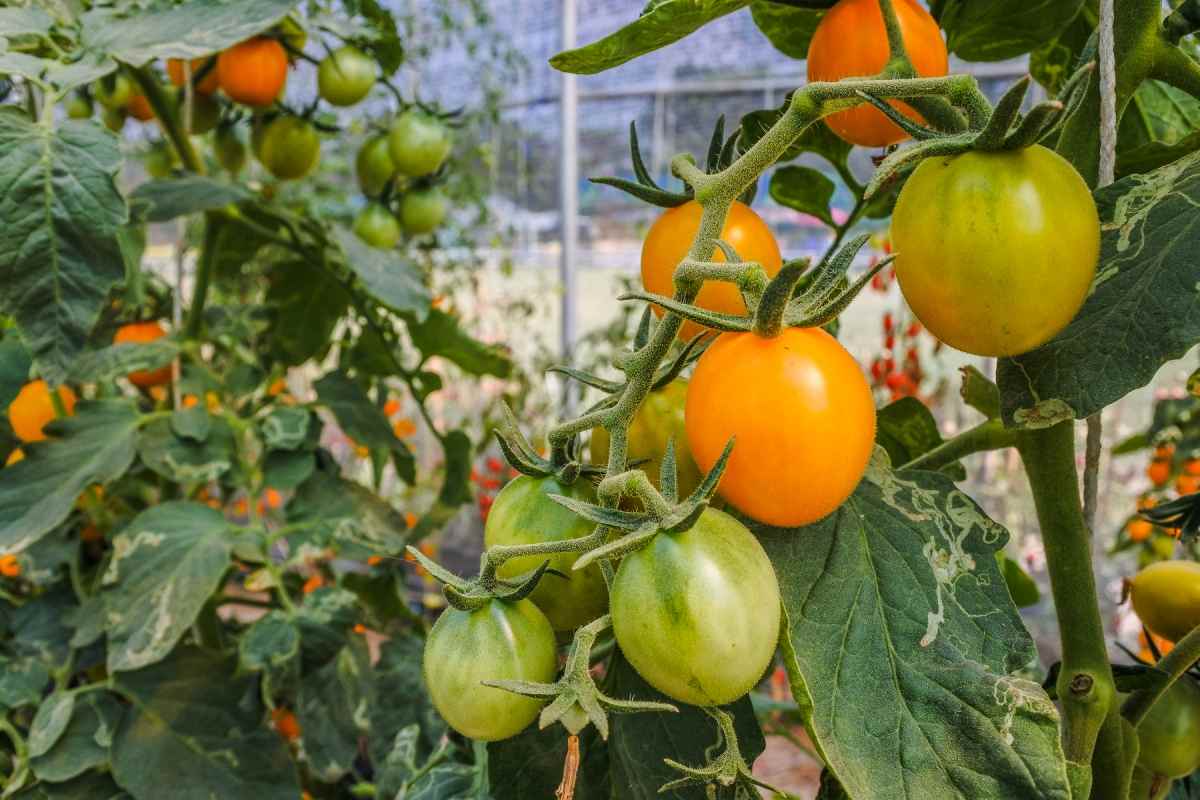Introduction to growing Tomatoes organically
Tomato belongs to the genus Lycopersicon under the Solanaceae family and it is an herbaceous sprawling plant growing to 1-3 m in height with a weak woody stem. It is one of the most important and widely consumed solanaceous fruit vegetables in the world. It gives a high crop yield within a relatively short period and it is economically attractive. So, the area under cultivation of this crop is increasing day by day. In this article we also discuss below topics;
- The best way to grow organic Tomatoes
- Best organic fertilizer for Tomatoes
- How to grow organic Tomatoes indoors
- Organic Tomato production guide
- Organic Tomatoes price
- Organic Tomato fertilizer
A step by step guide to growing Tomatoes organically

Soil preparation for growing Tomatoes organically
Tomatoes are not too finicky about soil type, while they will appreciate deep soil with plenty of room for their roots. Tomato plants grow best in neutral (pH) loam or sandy loam, and don’t love clay soil. If you have clay soil, amend it with sand, coco coir or peat moss to develop drainage and texture. If you are starting a new bed or filling a container to grow Tomatoes, use good quality potting soil mixed with aged compost. Soil is rich in compost and organic matter and has a good balance of moisture retention and drainage alike perfect for Tomatoes.
Good soil is the foundation of organic Tomato production. Building soil with a combination of cover crops, green manures, compost, and rock minerals, will give you with the high yielding Tomatoes. Tomatoes prefer slightly acidic soils with a pH level of 6.0 to 6.8. Growing Organic Tomatoes on sandy soils, which warm earlier in the spring, encourages early fruit production.
Organic production of Tomatoes
Organic agriculture consists of a system of farm design and management to make an ecosystem, which can achieve sustainable productivity without the use of artificial external inputs such as chemical fertilizers and pesticides. The main aims of organic agriculture are the production of quality agricultural products that contain no chemical residues, the development of environmentally friendly production methods, and the application of production methods that restore and maintain soil fertility. These are achieved by suitable plant selection and rotation, recycling of plant and animal residues, proper tillage, and water management.
Organic farm products are more expensive than inorganic crops. Crop yields drop sharply during the phase of conversion as it takes some time for the soil and plants to reach equilibrium. Though, yields rise again, once management systems get established. As the present level of farming is less intensive with lower levels of application of chemical fertilizers and also pesticides transition to organic farming in the state will be comparatively easier.
Rotation – Crop rotation is a major component of organic farming, affecting soil conditions and pest cycles. Rotation with non-solanaceous crops like pulses or legumes is suggested to avoid pests and diseases affecting Tomato and also to enrich the nitrogen status of the soil.
Soil Fertility – Keep fertile soil by regularly adding organic matter to it. If you have been practicing organic farming on land for many years, then your soil has good nutrient content. Just ensure that you are rotating Tomatoes with legumes once every few years so the soil remains rich in nitrogen. You can add compost, barnyard manure, and poultry litter to further enrich the soil.
Planting material – Tomato is propagated by seeds and seed selection is an important aspect in organic Tomato production. For raising nurseries, seeds of high yielding varieties with tolerance to pests and diseases can be used. They must be carefully selected from certified organic farms or from their seed plot which is raised organically. To start with, chemically untreated seeds from local high yielding Tomato varieties could also be used, in the absence of organically produced seeds.
Varieties of Tomatoes for growing organically
For organic farming of Tomato, Open Pollinated Varieties (OPV) is preferred. The local varieties are Swarna Lalima and Swarna Naveen are generally suitable for organic cultivation of Tomato. Lakshmi NP 5005 is popular in the State as it is resistant to bacterial wilt and leaf mosaic virus.
The seed rate and seed treatment in growing Tomatoes organically
For raising the seedlings in nursery bed 300 to 400 g/ha seeds are required. Hybrid seeds are very costly so it should be sown in plastic cups or ice cube tray, which require 70-90 g.
To avoid damping-off disease treats the seed with Trichoderma by 5-10 g/Kg seed or carbendazim 2g/Kg seed. The treated seeds are dried in shade for 30 minutes and sown sparsely along the lines in ½ cm depth and then covered by the topsoil.
Tomato plant spacing
In case if you miss this: Hydroponic Tomato Farming.

The spacing recommended for the autumn-winter crop is about 75 x 60 cm and for the spring-summer crop 75 x 45 cm.
Irrigation management for growing Tomatoes organically
Water requirements for Tomato plants will vary with climate, soil type, and plant size. On average, Tomatoes will use 1 to 1.2 inches of water weekly. Irrigation systems used in Tomato production contain surface and furrow flooding, overhead sprinklers, and drip or trickle. Flood irrigation requires the least equipment but is the least water-use efficient. Flooding is used for large scale plantings. Sprinkler irrigation is sometimes used, but wetting the fruits and leaves and splashing of water from the soil to foliage will increase the risk of disease. Drip irrigation system efficiently supplies needed moisture directly and at a more consistent rate to the crop plants compared to overhead irrigation systems but materials costs and labor are higher.
Tomatoes need careful irrigation that is just sufficient water at the right time. It is necessary to keep an even moisture supply. During summer, irrigation at every 5 to 7 days interval is necessary, whereas in winter 10 to 15 days interval is sufficient. A period of drought followed by sudden heavy watering during the fruiting period may cause cracking of Tomato fruits.
The cost of organic Tomatoes
The cost of Fresh Organic Tomato is approximately Rs 30 to 50/kilogram (retail), but you get less price at farmgate.
Tomato fertilizer options for growing tomatoes organically
Tomatoes need organic fertilizer at certain stages of their growth depending on the plant nutrients available in the soil.
Some of the organic natural Tomato fertilizer can be given below;
Compost – A compost pile will produce rich, pure organic matter loaded with necessary nutrients and beneficial microbes. Compost has all the basic nutrients, both macronutrients, and micronutrients, that are absent in synthetic fertilizers. Compost releases the nutrients gradually, thus providing long-lasting nutrition. It not only helps in fertilizing Tomatoes but helps the soil to retain nutrients and water, neutralize the soil, and adds beneficial microorganism to the soil.
Epsom Salt – Tomatoes use lots of magnesium while growing, Epsom salt helps give Tomatoes with the necessary magnesium. You’ll see more blooms, stronger plants, more Tomato fruit production, deeper green color, along with taster, sweeter Tomatoes. Make sure to cover the Epsom salt with a thin layer of dirt, and before placing the Tomato seedling in the hole.
Fish Emulsion – This is another natural Tomato fertilizer that gives an extra boost, both at transplanting and during the growing season. Fish emulsion is available as a concentrated water-soluble liquid fertilizer made by blending different parts of the fish including bones.
Organic Cottonseed Meal – This is an ideal natural fertilizer that can be added as an organic soil amendment at the time of transplanting seedlings. Cottonseed meal is rich in potassium, nitrogen, and phosphorus in a ratio of about 6-2-1. The high level of nitrogen supports foliage growth during the early stage of Tomato plant growth.
Vegetable-Based Organic Fertilizers for growing organic Tomatoes
Some of the best vegetable fertilizers include;
Alfalfa Meal – Alfalfa meal is a complete NPK fertilizer and is packed with loads of micronutrients and useful hormones. Tomatoes planted in compost and dressed with an alfalfa mulch cover thrive well. Mulch tomato plants to help reduce moisture loss from evaporation.
Seaweed – If you live near the beach, try feeding Tomato plants seaweed; they might be low in NPK but has over 60 trace elements that are crucial for fruit formation.
Advantages of using organic Tomato fertilizer;
- Improves the soil long-term by helping organic matter break down contains trace nutrients, rather than just the top three major nutrients such as nitrogen, phosphorus, potassium
- Releases nutrients gradually and lasts longer in soil
- Available in both granular and liquid (fish emulsion) forms
Disadvantages of using organic Tomato fertilizer;
- Three major nutrients such as nitrogen, phosphorus, potassium are not balanced
- Weaker strength means fertilizing more during the growing season, which can increase expenses
- Can have damaging pathogens if fertilizer is not properly composted
Cultural practices in growing Tomatoes organically
You should not miss this: Greenhouse Agriculture in India.

These weeds start growing 4 to 5 weeks after transplanting the Tomato saplings. Thus, the focus has to be on extensive weed control during this period. Weeds should not be allowed to grow in numbers and organic weed control can be achieved by using organic matter as mulches as these restrict weed growth. Crop rotation, mulching, sanitation, and shallow tilling help in controlling the weeds. After transplantation, regular weeding is necessary to be done to remove harmful weeds from the field. The Tomato plants can be provided support with the help of small bamboo sticks to increase the production.
Organic pest control in Tomato plants
It has been observed that growing organic Tomato plants have fewer pest and insect problems than conventional chemically grown Tomato plants. Also, if you practice proper crop rotation, the life cycle of insects and pests is broken, so you have a smaller pest menace. Trap crops are effective in controlling pests. Sweet corn is an example of the trap crop. Sweet corn attracts Tomato fruit worms and thus protects Tomato crop when inter-planted with it.
Being ‘organic’, as the term, mainly suggests the use of synthetic fungicides, weedicides, pesticides are prohibited. Natural enemies of the pests are grown and then protected. For weeds, the manual weeding process is done and weeds near the base of the plants are pulled out and recycled as mulch in the field. Plant-based repellents, neem seed kernel extracts, mechanical traps, pheromone traps, clay, soft soap, and chromatic traps are permitted for use in the Organic farms. In case of absolute necessity, the certifying agency should be consulted and the following products must be used;
- Mineral oils like kerosene
- Plant and animal preparations
- Bordeaux mixture
Organic insecticides like neem fertilizer are another option if you want to ward off the common pests and diseases of the Tomato plant. Also, frequent checks of the plant are another way to save the Tomato plant from some common problems. Also, organic seaweed fertilizers are a great way to promote more fruit in the plant. You can dilute the liquid seaweed concentration depending on your plant needs.
Fungal Prevention – Fungal diseases such as powdery mildew can be prevented using a spray made of baking soda or potassium bicarbonate, horticultural oil, and water. If you don’t have horticultural oil, then use citrus oil or molasses makes a good substitute. Also, milk deters powdery mildew. For this, mix 1 part of milk to 9 parts of water in a spray bottle for easy application. Cornmeal can be used to manage fungal infections. Mix 1 cup of cornmeal with 5 gallons of water, strain, and spray on Tomato plants.
Aphids – These are those dense clusters of tiny insects you may see on the stems or new growth of Tomato plants. While small numbers are not a big deal don’t be afraid to crush them with your thumb large infestations can gradually injure or even kill Tomato plants. If the problem then seems manageable, release beneficial insects such as ladybugs and lacewings. If it doesn’t, go for the insecticidal soap that uses natural fats and plant oils or natural sprays, many of which are useful for Tomato organic production.
Cutworms – These are the tiny grub-like caterpillars that feed on young Tomato plant stems at night, frequently felling seedlings by eating right through them at ground level. Prevent damage by placing collars around seedlings. You can make these of paper, cardboard, aluminum foil, or an aluminum pie plate about 10 inches long and four high, bent to form a circle or cylinder and stapled. Sink the collars about an inch into soil around individual seedlings, letting 3 inches showing above the ground to deter high-climbers.
Hornworms – These destructive caterpillars are so big that means three inches long or more that it would seem to be easy to control them just by picking them off. The dilemma is that their pale green color provides good camouflage, and the nymph and larval stages are far smaller and less obvious. If there are more than a few, other measures may be called for. One of these is Bacillus thuringiensis, an organic treatment that can control numerous other caterpillars as well.
Tomatoes harvesting and yield per acre
You may also check this: Organic Turmeric Cultivation in Polyhouse.

Tomatoes can be harvested within 2 to 3 months of the plantation. Depending on the market demand, 8 to 10 harvesting of Tomato is done every year. The average Tomato crop yield per acre in India is about 10 tonnes although the yield varies from 15 to 20 tonnes per acre in case of irrigated crops.
The first harvesting of Tomato plants usually starts in 75 to 90 days from planting. While considering the market distance and transport mode, Tomato fruits must be harvest as follows;
Green stage – If you are sending Tomato fruit for a long distant market, then harvest at the Maturity stage with green color.
Pink stage – The Tomato should be harvested by changing the color of the green color to the pinkish appeared. It is better to send such fruits to nearby markets.
Maturity stage – To sell the Tomato in the local market, harvest after the fruit is reddish on the tree.
Full maturity – In this state, the fruit is slightly red and fully reddish on the tree. Such fruits are useful to make durable materials such as ketchup, sauce, soup, chutney, etc.
In case if you are interested in How to Make Money from Organic Fertilizer Production.
To teach me how organic farming is done